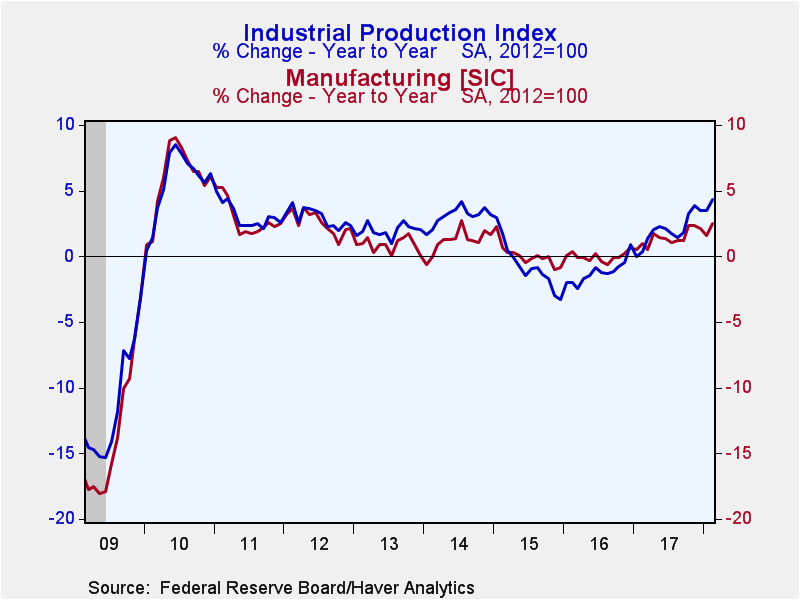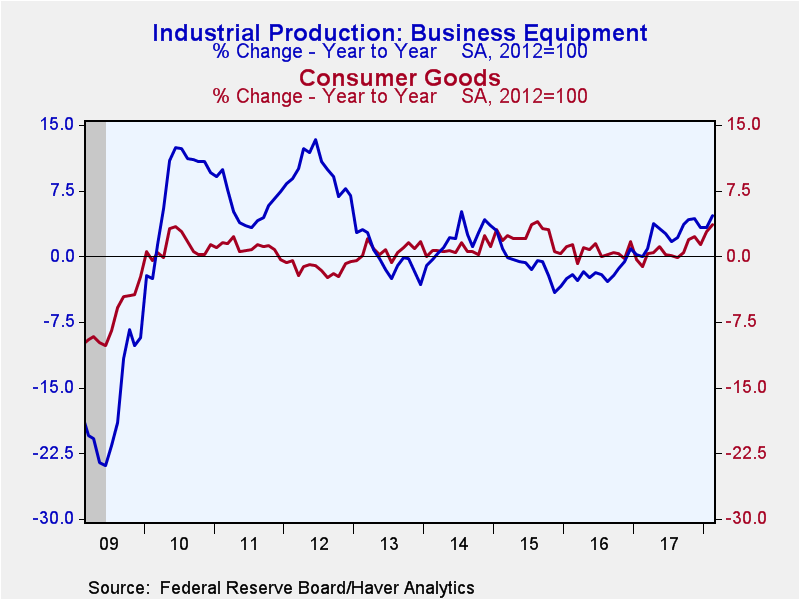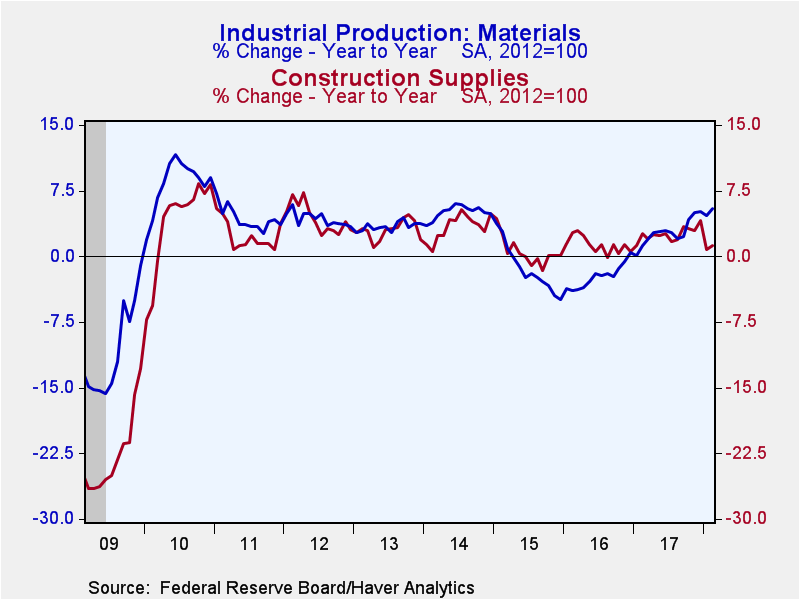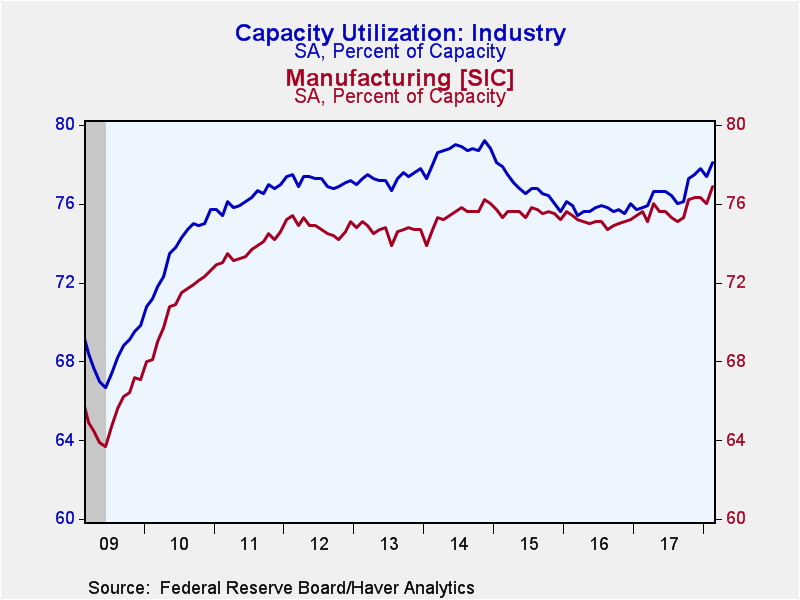 Global| Mar 16 2018
Global| Mar 16 2018U.S. Industrial Production Strengthens
by:Tom Moeller
|in:Economy in Brief
Summary
The Federal Reserve reported that industrial production increased 1.1% (4.4% y/y) during February following a 0.3% January dip, revised from -0.1%. It was the largest increase since October 2017. A 0.3% rise had been expected in the [...]
The Federal Reserve reported that industrial production increased 1.1% (4.4% y/y) during February following a 0.3% January dip, revised from -0.1%. It was the largest increase since October 2017. A 0.3% rise had been expected in the Action Economics Forecast Survey. Factory sector production strengthened 1.2% (2.5% y/y) following three months over which production was unchanged. Utility output declined 4.7% (+10.6% y/y) after two months of strong increase. Mining production surged 4.3% (9.7% y/y), the largest increase since October 2008.
Strength in factory sector output reflected a 1.0% increase (4.6% y/y) in the production of business equipment which followed a 0.1% easing. Transit equipment production rose 1.9% (2.8% y/y) following a 0.6% increase, and information processing & related product output gained 1.3% (4.9% y/y) after a 1.7% rise.
Total consumer goods production increased 0.1% (3.7% y/y) following two months of 0.5% rise. Durable consumer goods production rose 2.8% (2.6% y/y) after a 0.8% decline. Automotive product output jumped 3.9% (3.2% y/y) following a 1.4% decline. Computer, video & related production gained 2.0% (8.8% y/y) after a 1.6% decline. Appliance, furniture & carpeting production rose 2.1% (1.0% y/y) following a 0.7% decline. These gains were offset by a 0.7% decline (+4.0% y/y) in nondurable consumer goods production which followed a 0.8% rise. Energy product output weakened 6.1% (+11.6% y/y) after a 1.9% increase. Apparel production gained 1.1% (-3.0% y/y) after a 0.6% rise. Paper product output increased 1.4% (-1.7% y/y) after a 2.0% decline. Chemical product production eased 0.2% (+3.3% y/y) after a 1.1% rise.
Construction supplies output increased 2.3% (1.2%y/y) after a 1.9% decline.
Production of materials improved 1.6% (5.5% y/y) after a 0.5% decline. Durable goods materials output jumped 1.9% (2.5% y/y) and nondurable goods materials rose 1.1% (2.2% y/y).
In the special aggregate groupings, production in selected high-technology industries rose 1.0% (8.3% y/y) following a 0.2% dip. Nonenergy production excluding high-tech rose 1.5% (2.2% y/y). Factory sector production excluding both high-tech and autos improved 1.0% (2.4% y/y) after two months of slight decline.
Capacity utilization increased to78.1%, the highest level since level since January 2015. Factory sector capacity utilization rose tot 76.9%. Electric & gas utility utilization declined to 76.9%.
Industrial production and capacity data are included in Haver's USECON database, with additional detail in the IP database. The expectations figure is in the AS1REPNA database.
| Industrial Production (SA, % Change) | Feb | Jan | Dec | Feb Y/Y | 2017 | 2016 | 2015 |
|---|---|---|---|---|---|---|---|
| Total Output | 1.1 | -0.3 | 0.5 | 4.4 | 2.0 | -1.2 | -0.7 |
| Manufacturing | 1.2 | -0.2 | 0.1 | 2.5 | 1.4 | -0.0 | 0.1 |
| Consumer Goods | 0.1 | 0.5 | 0.5 | 3.7 | 0.5 | 0.6 | 2.3 |
| Business Equipment | 1.0 | -0.1 | -0.2 | 4.6 | 2.6 | -1.8 | -0.9 |
| Construction Supplies | 2.3 | -1.9 | 0.9 | 1.2 | 2.5 | 1.3 | 0.5 |
| Materials | 1.6 | -0.5 | 0.5 | 5.5 | 2.8 | -2.3 | -1.4 |
| Utilities | -4.7 | 1.3 | 3.6 | 10.6 | -0.4 | -0.3 | -0.7 |
| Mining | 4.3 | -1.5 | 0.3 | 9.7 | 6.9 | -9.1 | -4.3 |
| Capacity Utilization (%) | 78.1 | 77.4 | 77.8 | 75.8 | 76.5 | 75.7 | 76.8 |
| Manufacturing | 76.9 | 76.0 | 76.3 | 75.6 | 75.6 | 75.1 | 75.5 |
Tom Moeller
AuthorMore in Author Profile »Prior to joining Haver Analytics in 2000, Mr. Moeller worked as the Economist at Chancellor Capital Management from 1985 to 1999. There, he developed comprehensive economic forecasts and interpreted economic data for equity and fixed income portfolio managers. Also at Chancellor, Mr. Moeller worked as an equity analyst and was responsible for researching and rating companies in the economically sensitive automobile and housing industries for investment in Chancellor’s equity portfolio. Prior to joining Chancellor, Mr. Moeller was an Economist at Citibank from 1979 to 1984. He also analyzed pricing behavior in the metals industry for the Council on Wage and Price Stability in Washington, D.C. In 1999, Mr. Moeller received the award for most accurate forecast from the Forecasters' Club of New York. From 1990 to 1992 he was President of the New York Association for Business Economists. Mr. Moeller earned an M.B.A. in Finance from Fordham University, where he graduated in 1987. He holds a Bachelor of Arts in Economics from George Washington University.










